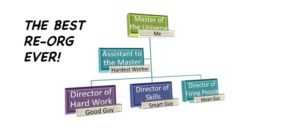3 Top Tricks To Org Your Re-Org!


There are no shortage of frustrations in business. Many times as we are shaking our head in despair we imagine our problems could be solved, or at least greatly helped, by reorganizing our department, team or company. Many times a Re-org is an appropriate thought, particularly if you’ve experienced significant changes in your volume (up or down), efficiency, automation or product variety, or changes to your staffing level or skill sets or process requirements.
There are also times when the problem is not how you are structured or organized and a reorg is a mirage, distraction or pipe dream. For now let’s suppose you’re on solid ground in benefiting from a re-org. There are a few “tricks” that can help you gain confidence in your choices. A process to make sure you get it on the button with the roll out; basically to organize your reorg.
Trick #1, Ask: Is it the People or the Position?
Loyalty can be a critical employee and leadership bond, but can also be a dragging bondage so you must ask yourself do I feel the need to reorganize around staff deficiency or do I need to redefine the requirements of the position? In truth, both things happen. Decide honestly if you need new people, performance or new positions/job descriptions. We sometimes try to hide someone’s weakness whom we want to keep by redefining their job requirements. You may or may not be doing yourself or the employee a favor when this happens but recognize that the ideal way organizations work is to have jobs that are defined by requirements to make processes optimal and are filled by people who meet those prerequisites and we manage them to excellence in their performance. Organizations that define jobs around people may solve one problem but they are likely moving, lessening or postponing the problem down the line.
Trick #2, Discover what is Skill, Will or need to Kill
We look at jobs and job descriptions primarily as details about how and what they do in processes. What we too often undervalue are the specific skills and their requisite levels of expertise in each of our org chart boxes. True, while several of the same job descriptions will be populated by people of different skill (and will) levels it is critical to assign the success level of both skill and will to all positions. How much self motivation or oversight does a job require? Additionally, make sure to ask what aspects of a job do you need to kill, replace or stop doing. Every reorganization, no matter how minor or major, should be an occasion to take a fresh look. Like cleaning out a closet, we may try to convince ourselves that sweater we haven’t worn in 8 years is still good to keep, and doesn’t do any harm up high on the shelf, likewise there are probably process remnants and artifacts and even skill or will elements in your jobs that maybe should end up in a giveaway box, next to that lovely, but useless sweater you’ll never wear.
Trick #3, Visualize but identify what’s Core, Less and More
Depending if you are a visual or auditory type person you may relish drawing lots of boxes and double arrowing reporting lines on scrap paper or computer apps or you may prefer to talk it out with people, ask questions, make notes. For best results you need to do both. Drawing the org chart is a critical visual to point out things like over-stretched reporting lines or overburdened sections. You get a basic view if you are developing a more vertical or horizontal organization, either may be appropriate, and it helps you assess things like salary values or inequities. Too often though we draw boxes and then write job descriptions but we lack a catalyst for understanding change. Fundamental to your re-org is the fact you are building in change.
While Change Management is it’s own topic beyond our scope here a great little analysis tool is to take every job, and/or each person you are assigning to an org box and detail in writing what is Core to that job, and it doesn’t hurt to do this venture with all or most of your team. What are you asking the position or person to do More of and what do you want or need them to do Less of. The core sets the parameter but doing more or less can be about prioritizing, load balancing or changing how or what gets done when and why by whom.
Sometimes we reorganize a person’s job with what feels like a tweak or maybe it justifies a promotion but if you are asking someone to do more of something they often need to do less of something else to make room for new or extra tasks or responsibilities, either way it needs to be clear. If less is needed then can it be delegated, automated or eliminated? As you move people and draw lines remember it all comes down to process and responsibility so look at the core, what more and less is needed for every job in your organization, even if on the periphery of a re-org it is a valuable technique to continuous improvement. That, after all, is what your re-org should really be about.
© 2017 MyEureka Solutions, www.myeurekasolutions.com
